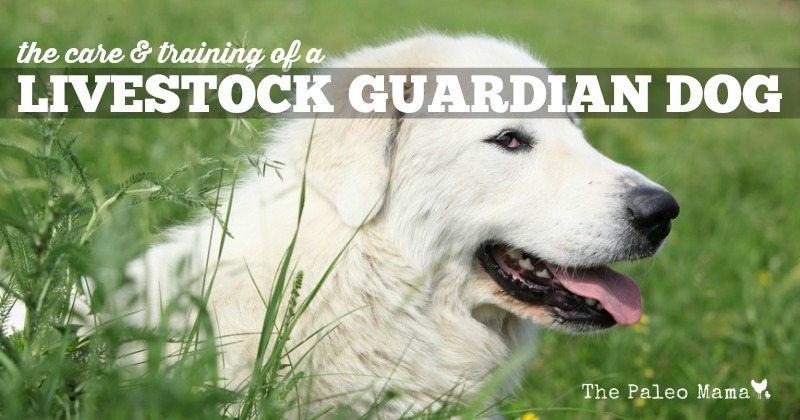
I know that by now you have seen the many pictures I have posted of our wonderful Livestock Guardian dog, a beautiful Great Pyrenees named Esme. She has been a great addition to our family, and by now, at more than eighteen months of age, she has developed into a fantastic guardian dog for our goats and chickens. The care and training of a Livestock Guardian Dog is an investment that will NOT disappoint, as long as you do it the right way.
Great Pyrenees are one of the oldest dog breeds in the world. They were bred as dogs of war and then used during peacetime as sheep guarding dogs. They are one of the least aggressive of the large guardian dogs (LGD), so often people cherish them as family dogs. They are regal, independent and aloof compared to other dogs breeds, traits necessary to spend days alone guarding flocks. This independence shows when you call them—they come, but maybe not on the first call.
Raising a livestock guardian dog is much different than raising a pet dog who lives with you in your home. Making the right decisions in the period of training will guarantee that you livestock dog performs his duties perfectly for the rest of his life. But choosing to raise him as a pet with little or no specific guardian training will give you a dog who cannot be trusted with your livestock.
Raising puppies to become livestock guardian dogs is a 12 month to 18 month venture. These breeds of dogs are slow to mature and thus are often not trustworthy and reliable before this age. I want to take a brief look at three major areas of training for a livestock guardian dog.
- How do I teach my livestock guardian dog to bond with my livestock?
- How does my livestock guardian dog learn to obey fence and gate boundaries?
- How do I socialize my livestock guardian dog to people and my surroundings?
How do I teach my livestock guardian dog to bond with my livestock?

Livestock guardian breeds come with an inherent ability to guard that which they bond to. When you bring your pup home be prepared for him to spend the night where you expect him to spend his nights as an adult. With the stock. Not in your house.
Every day the pup will need to exercise and have interaction with his charges. You can allow free time outside the puppy pen whenever you are around to keep an eye on the action. For the first few weeks, lock the pup up when you are not there to supervise. During the small puppy-stage (which doesn’t last long in a Great Pyrenees) we used a large dog kennel and kept it in the barn with the goats. Our Esme slept in the large dog kennel at night and during the day we put her in a separate fenced section. She could smell and be out with the goats and chickens, but the fence kept her from developing any bad habits of chasing the livestock.
NEVER throw your puppy in with your livestock and expect him to naturally take on the role of a Livestock Guardian Dog. A Great Pyrenees does NOT equal a good Livestock Guardian Dog. A well-trained and time-invested Great Pyrenees DOES!
Over the next several months supervise the pup and discipline any unwanted action toward the animals such as chasing, chewing, and biting. And by discipline, I do not mean you EVER hit or kick a livestock guardian dog. This will leave a bad impression and could ruin the demeanor of the dog forever. You firmly say, “NO…my chickens,” and then walk away from the dog and show them no attention. If they continue to misbehave, you lock them in their pen (which they utterly hate). You can also praise the pup for good behavior. Pet and feed the pup when he is with the livestock, not when he is away from them so that he never develops the bad habit of being possessive of his food. Do not take the pup up to the house for food and attention. As the pup matures you will notice if he is bonding to your livestock or not.
If the dog is to guard, it is not good to raise it around other non-Great Pyrenees dogs where it can pick up bad habits such as chasing poultry or livestock. Great Pyrenees don’t normally chase, but if the big puppy bounces up to a chicken and the chicken runs the other way, the dog will give bounce after it. Once chasing starts, the chicken soon becomes a diversion, and that dog can no longer be trusted with poultry. Closely monitor your Great Pyrenees puppy for its first 12-24 months if you desire to raise a trustworthy poultry guard. Some dogs take 2 years to become trustworthy around chickens. We found that Esme took 15 months till we were confident in leaving her alone with the chickens but the training was SOOOOOO worth it.
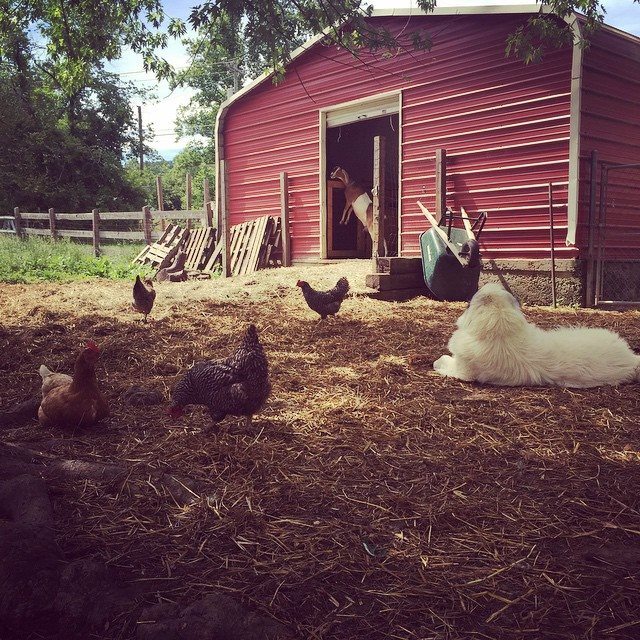
How does my livestock guardian dog learn to obey fence and gate boundaries?
A large part of success with raising puppies is being able to teach them to respect boundaries. Under no circumstances is climbing over or crawling under the fences going to work. Supervise and correct any attempts to go over or dig under fences as you see them. Use the time that you have the dog nearby and bonding to stock to set up the enclosure with hot wires, and allow the dog to learn the consequences of crossing electric fences.
Gates also need to be included in the training. LGD’s are smart dogs and will figure out that fences may be not so good but gates are okay. They need to know they do not cross gates unless invited out by you or moving with the flock. When raising puppies doing the work of teaching the pup respect for fences will go a long way to eliminating the core problem seen in LGD’s—wandering away from the flock and farm.
Adult Great Pyrenees will naturally cover a one to two mile radius. If that’s not allowable, the dog will have to be trained to a smaller area. Fences, electric fences, and invisible fences all work good. Neutering helps to keep a male dog at home. Close supervision and correction the first two years will help yield a dog that stays within the property lines.
When you bring your new puppy home, make sure you walk the perimeter of your property every day for a few weeks so that pup understands it’s boundaries.
How do I socialize my livestock guardian dog to people and my surroundings?
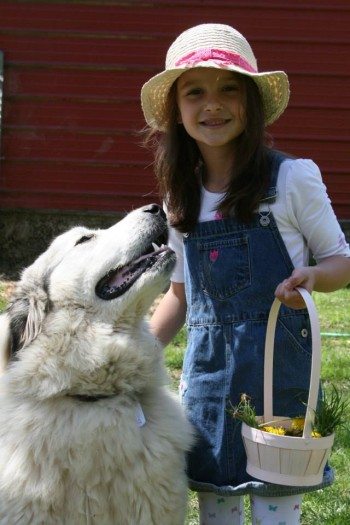
The calm nature of Great Pyrenees livestock guardian dogs around livestock, combined with proper training, will bring out the naturally gentle and submissive breeding that makes these dogs a wondrous thing to behold around small and delicate kids and lambs. However, we need to always remember that these dogs aren’t bred for obedience. Patience is a must. We expect our LGDs to think and react when we aren’t there to protect our flock. We cannot simultaneously expect independent thinking and mindless obedience. These dogs are ALWAYS multitasking; they are bred to reject human instructions where they see a better way to behave. This is what makes them the perfect pasture companions to our chickens, sheep, goats, cattle and even horses. This is also why we have trouble with them obeying fencelines and expanding their territory. They are good at what they do, and they know it. Be patient with them and they will be everything you expect, and then some.
Some livestock guardian dog trainers believe that LGD pups should be raised with the livestock they will be guarding, isolated from humans. In reality, this is an exaggeration of recommendations made by scientists in the USDA bulletin about selecting, raising, and using LGDs. The publication’s language about minimizing the dog-to-human bond has been incorrectly interpreted to mean elimination of contact with humans. Training cannot be accomplished without human contact. We love, pet, show affection to our Esme, and in return, we have seen that nurturing blossom into an incredible human-dog bond.
Livestock guardian dogs are working dogs and a balance of how much interaction to have with the dog must be found. Be wary of how much attention you foster on the pup. The idea is not to make him into a pet but to let him know your touch by petting him and handling him. Let him know you control the food, and the access to stock and you set the boundaries. LGD’s grow into large independent natured dogs. You will need to stay on top of the pecking order, not by using force but by quietly assuming the role because it is your place and your stock and your duty to keep everyone safe.
The health of your Great Pyrenees livestock guardian dog
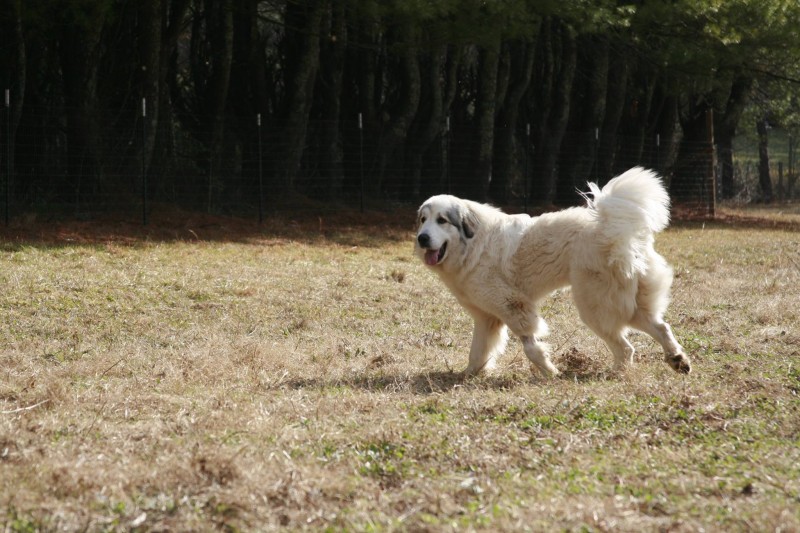
Great Pyrenees generally stay in good health. Some more common problems may include mats in the fur (especially around the neck and ears), the double dew claws growing too long, ear infections (due to dirt and moisture in the ear), eye infections (pink eye), allergies and “hot spots”. Hot spots are caused when an area of the skin becomes inflamed. The fur will fall out, the skin will turn bright red and the dog wants to bite at it. Some ointment from the Vet and keeping the spot dry cures this problem or a mixture of lavender and melaleuca essential oils mixed into a all purpose salve (here’s my recipe I use).
Genetic problems include: underbite, entropia (small eyeballs), seizures and hip dysplaysia. Pronounced underbite shows up as wet spots under the chin and neck. Entropia is when the eyeballs are small for the socket size and the eye lashes stick inward causing irritation. This can be cured with simple surgery, but the dog should not be used for breeding. The cause of seizures is unknown, but from what we have heard, changing owners, being confined to a small area, or other highly stressful situations will tend to bring them on. Hip dysplasia is not quite as common as in other breeds because Great Pyrenees have not been over bred. The most common form of death that we hear about is being hit by a car or being stolen.
We had to have stomach surgery on our Esme due to the fact she ate two rocks that got lodged in her stomach and small intestine. Thankfully, she made a full recovery! We corrected this behavior by providing her plenty of raw marrow bones to chew on in the late puppy stage and continuing to feed her a large breed high quality puppy chow to supplement the raw feeding that we do with her when we have extra meat laying around.
Conclusion:
Investing in a Livestock Guardian Dog was the BEST decision we made when we started our homestead. We found our puppy on Craigslist and she came from a working farm with working parents. We have invested hours of training into her and I couldn’t imagine our farm without her. The ultimate satisfaction of this investment comes when I look out the window and I see her laying down near where the goats are grazing and our free-range chickens are pecking happily in the dirt beside her.
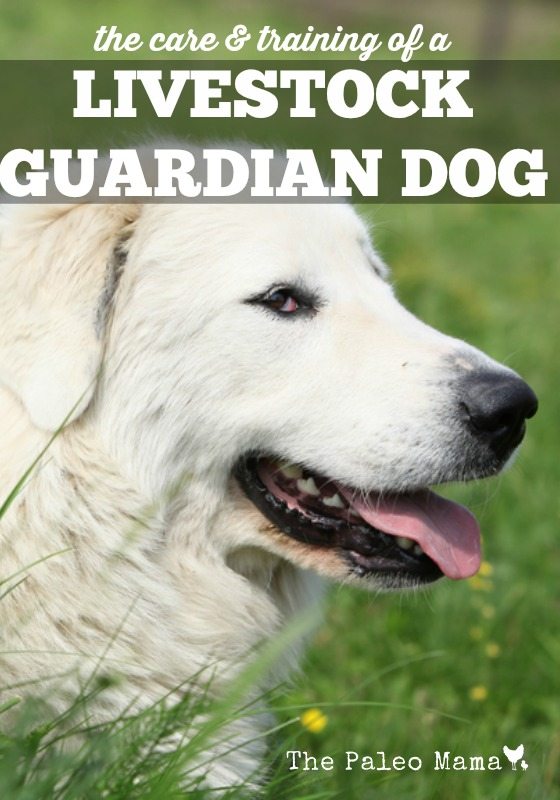
Great article. I love dogs. Dogs are always helpful even though it has been chosen or not. Thanks
It’s so helpful to hear the details of your experience. We recently lost our Weimaraner (a bird dog–yikes!) who was a beloved pet but did not mix well with our poultry. We had the dog before acquiring our chickens and weren’t willing to part with him, but it was a real challenge to keep the hens alive! Now we have the opportunity to choose our next dog and are trying to determine whether the cost is worth it. My husband is considering Anatolian Shepherds, but they cost about $1000. Which would make for pretty expensive eggs! 🙂 I’m passing your article along to him…Thanks!
We have had several Pyrenees over the years, some pets and some Livestock guardians. we loved them all but in the Central Texas Heat hotspots always happened. Our Latest Guardian is Sophia and she has one Great grandmother who was Anatolian. She looks 100% Pyrenees acts 100% and is very protective of our Goats and Ducks. two summers under her belt and no hotspots. We are hoping this is due to the crossbreeding but have not heard anyone else comment on this.
I dearly LOVE Great Pyrenees. They are the most loving and naturally protective dogs I have ever known. (and I’ve known many dogs, within my own family and through my animal rescue work) I have been blessed to share my existence with 3 wonderful Pyrenees over the years. I am contemplating getting another Pyrenees as I have recently bought property out in the country and am in the process of setting up homesteading, with my next acquisition to be a flock of chickens. Being out in the country I will, obviously, need some help with protection from predators as we have bobcats, foxes and such in this area.However, I am hesitant to bring such a wonderful animal to the wilds of south Georgia, as our weather is so hot and humid most of the time. My first two Pyrenees, Max, and his son Edward, I had when I lived in Missouri,(a much more amenable climate for these dogs) My third Pyrenees, Cody, was a rescue after I had returned to Georgia. He had a horrible skin infection when I took him in, which I was able to clear up, but I think was directly attributable to the South Georgia climate. These are wonderful dogs. You can, quite literally, trust them with your life and the lives of your family, in addition to the protection of property. Does anyone have any sage advice about LGD’s that might be a good fit for my situation?
Leisa,
I don’t know if you are still considering a Pyrenees or not, but we have them in Western NC and they do fine in the heat. Contrary to what inexperienced owners may say, you do NOT shave them for hot weather. Their double coat actually helps them to handle the hot weather better. We provide plenty of shady areas and cool water and they naturally lie around like slugs when it is hot and humid.
I believe hotspots are more a problem of vaccination and inappropriate diet. We feed raw meat and bones with a small amount of vegetable matter and organ meat. We only vaccinate against rabies and we wait until 15 months before doing that. Check out Dr. Will Falconer’s website for more info on diet and shots. My beloved Angus (alpha of our pack) had allergies when we got him. I switched him to a breed-appropriate diet, cleared his skin issues up with essential oils and handled disease prevention holistically. The improvement in him was fast and has lasted. He is now 10 years old and doing great. Don’t listen to fear tactics or to those who stand to profit from scaring you into medicating your dog on a regular basis. There is a lot of info out there to coach you along as you adopt a natural approach to pet care. We operate a holistic family and farm. It is easy and we avoid all the vet bills and doctor bills everyone else seems to tolerate as “normal”. I wish you all the best!
Any advice on how to work with and train older dogs??
we raised them when i was in Oklahoma with our goats and had hot spots a lot then stared shearing them down to about inch long hair and that stopped it now im in Kentucky and fixing to buy a 10 acre homestead if i get hot spots ill shear them too mid summer worked best in Oklahoma still had the time for growth b4 winter
How do you train a 5 year old, not neutered dog to stay in boundaries? I got him recently and we have 160 acre which we are not able to fence with electric fence. Is there any chance to keep him on the property? Does anyone have experience with that? I am afraid I have to give him back, because he would make my neighbors angry over time.
We haven’t used electric fencing with our Pyrenees and have been fortunate in not having any climbers. I suppose if one of ours decided to develop that vice, we’d put him in a smaller area that we could hot wire. We do 4 rail high board fencing on our perimeter and goat and cattle fencing for interior pastures.
Wonderful article! Thanks so much.
We recently acquired a GP puppy to help with our flock of 20 or so chickens, and eventually our dairy goats (which we have not purchased yet, as we just bought the property about 5 months ago, and haven’t yet installed a proper pen for goats).
Our puppy has been with us for 6 weeks, and im wondering if I can recover from some of the mistakes i may have made with him so far. He is now 14 weeks old, and we’ve had him since he was 8 weeks. He has never been allowed inside the house, but we did get him used to sleeping in his kennel on the back porch. I realize now I probably should have put him with the chickens or near to them from the get go.
He does chase, but doesn’t nip at chickens.
Do you think I can recover from these mistakes?
Also, do you recommend regular “puppy training” classes for LGD’s?
Thanks!
Sarah,
Be wary of any trainer that has never worked with a livestock guardian. I had to travel with a political campaign I was working for last year at the time I acquired my latest Pyrenees puppy. I was absent during crucial weeks I would’ve normally spent training him. I decided to hire a trainer to recover lost ground when I got back home from my travels. What a mistake! This trainer assured me she could handle a working dog, but her tactics were definitely more appropriate for indoor lap dogs. She literally wanted us to race all over the yard, squealing with pleasure when the dog did anything we asked of him. The dog (and I admit, my family) thought she was nuts. It was a waste of time. She spent more time insisting my dog was grossly under-weight than she did training him. I was deliberately controlling his growth to ensure we avoided some of the hip issues, etc. you can encounter with rapid growth in a giant breed. Finally, to shut her up, I took him to my vet to have a second opinion on his weight (which I already knew was great). The vet thought he looked perfect and agreed that my methods were right on target for avoiding future problems. This trainer was probably great with lap dogs, but she was way out of her depth with a livestock guardian dog. I recognized this immediately and should have fired her. Instead, we tolerated ridiculous training sessions until the contracted time had ended. It was a waste of my time and money and the patience of the dog as well as my entire family. She should’ve admitted she was clueless and when she didn’t, I should’ve been more honest about telling her she was not qualified. So, short answer, yes, I think you can reclaim lost ground. Longer answer, be careful to do the work yourself or hire someone who has is qualified for the unique situation of a livestock guardian.
I have many years of animal training. Dogs, parrots, horses. I am ready to retire from gov job and want to go south to NC. Would love e to see LGD in action and purchase kennel to train these dogs for Animal Agricultural farming. I there any in the MD/DC area that are experienced in this field?
My GP puppy is afraid of our sheep.
He is 9 weeks old and has only been around them for short periods of time. But when he is, he cowers in the corner of the one and runs away if the sheep get close.
Any suggestions?
He’s still too young to train to be with animals. Give him time to grow up a bit and he should be fine. Introduce him slowly to just 1 or 2 smaller animals at a time.
Hello! Thank you so much for all this information! Wish I had, had it sooner!!! I got a Great Pyrenees back in March and only have 2 goats at the moment, recently I have noticed she has been resource guarding and is literally guarding her food from the goats within 50 feet if not more!! If they come within that range, she goes up to them and “herds” them I guess” But the bite marks on extremely large or bad, this CANNOT continue!!! Any tips would be absolutely wonderful!!! Thank you!